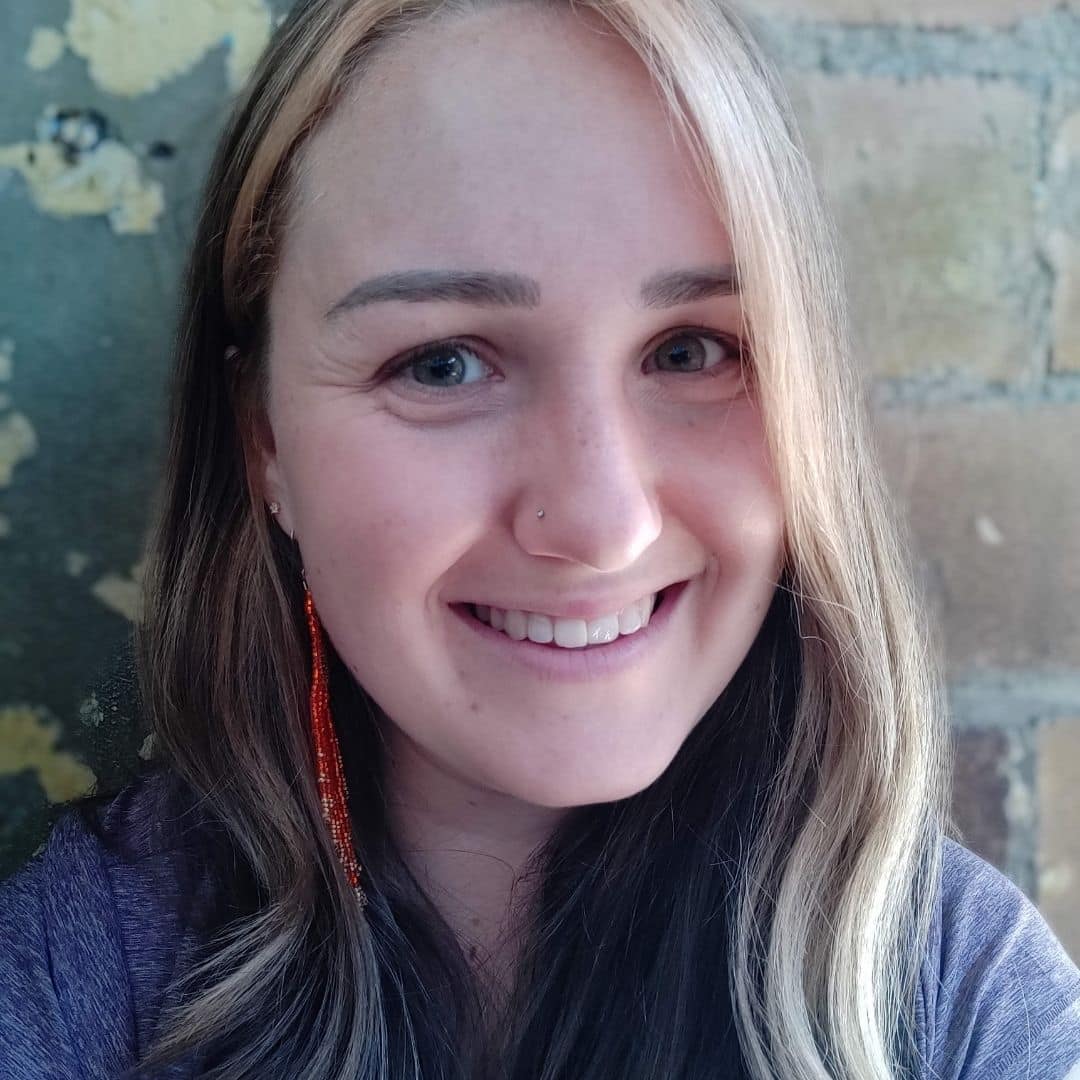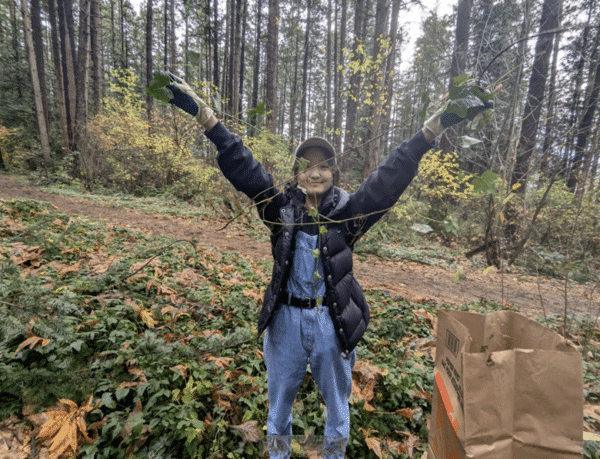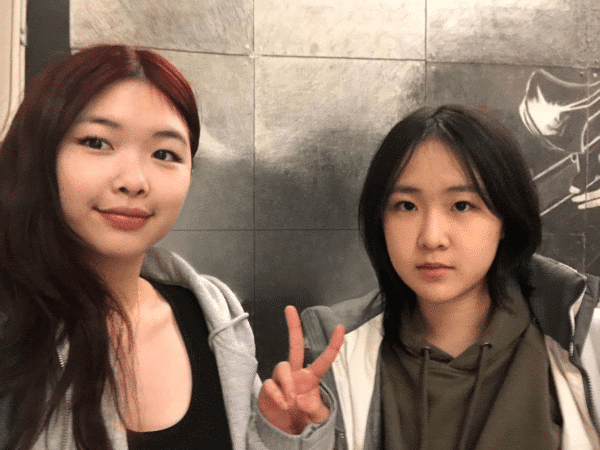Published January 12, 2021

Author: ISCBC youth volunteer Alison Chadwick
Have you ever wondered what is being done to inform ecological restoration plans in Vancouver?
This summer, myself, Damian Assadi and Marissa Petznek put our fieldwork gear on and visited Champlain Heights Park to conduct a series of self-directed site surveys to inform upcoming restoration plans, including the removal of invasive species. Our objectives were to identify invasive and native species, map invasive species, conduct bird surveys, and determine the level of biodiversity at the park.
Identifications
During our site surveys, we identified the following invasive species: Himalayan blackberry (Rubus armeniacus), English ivy (Hedera helix), English holly (Ilex aquifolium), Yellow archangel (Lamiastrum galeobdolon), Common periwinkle (Vinca minor), Scotch broom (Cytisus scoparius), European mountain-ash (Sorbus aucuparia) and Daphne (spurge-laurel) (Daphne laureola). A study conducted in 1996-1997 did not observe any Engish ivy which is currently spreading throughout the park [1].
We also identified 25 native species such as Pacific trailing blackberry (Rubus ursinus), Thimbleberry (Rubus parviflorus), and Oregon grape (Mahonia aquifolium). The native species identified in the park will be used to inform replanting strategies. Other native species to consider replanting include western hemlock (Tsuga heterophylla), Paper birch (Betula papyrifera) and Cascara (Frangula purshiana), which were recorded during the 1996-1997 assessment [1].
Invasive Species Mapping Demonstrated High Priority Areas for Invasive Species Removal
Avenza Maps and QGIS allowed us to map invasive species and visualize ‘high priority invasives’ and ‘emerging invasives’ (see Map 1 and Map 2). We defined the ‘high priority invasives’ as areas dominated by invasive species (e.g., Himalayan blackberry, English ivy) and invasives growing densely or covering a sizeable area (up to 993.8 m² (17–993 m²)). The ‘emerging invasives’ were characterized as not dominating the park (e.g., Common periwinkle), not growing densely, not covering a sizeable area (up to 138 m² (6 –138 m²)), or too tricky to currently remove without available equipment (e.g., saw, root remover). We conclude that the ‘high priority invasives’ are areas that need immediate attention.
Bird Surveys Produced Few Results
Our bird surveys produced few results. We believe this is due to human disturbances (e.g., loud music), which interfered with our surveys.
Biodiversity Levels Were Relatively High
Our biodiversity assessment revealed that despite the high levels of invasive species in Champlain Heights Park, the biodiversity levels were not low. According to our sampling stations, we had an overall Biodiversity Index that ranged between 0.56 to 0.74. A biodiversity index number closer to 0 suggests a low level of biodiversity, while a number closer to 1 indicates a high level of biodiversity [2]. Our results demonstrate a relatively high level of biodiversity, and the species richness and evenness can inform replanting strategies.
Our next step is to complete the Champlain Heights Park: Invasive Species and Biodiversity Assessment for 2021 based on the data we collected over the summer. The report will inform upcoming plans and strategies and will be shared with interested stakeholders.
Our project reflects the importance of conducting site surveys to inform restoration projects. However, ecological restoration projects should also include the voices of the local communities who are impacted by projects. For example, community-engaged research can bring diverse worldviews towards restoring ecosystems. We encourage future projects at Champlain Heights Park to engage with the local community and hear their opinions regarding the park’s restoration.
What do you think can inform restoration plans in your community?
References
[1] Gustafson, O., Reid, T., Sauvé, R., & Schroeder, G. (1997). Ecological Restoration Study in Everett Crowley Park: Ecological Succession in Vegetative Communities. Studies in Ecological Restoration at Everett Crowley, Vancouver, B.C. Volume 2. Capilano College: North Vancouver, BC.
[2] Maryland Science Center. (n.d.). Calculating Biodiversity. Maryland Science Center: Baltimore, MD. Retrieved from: https://www.mdsci.org/wp-content/uploads/2020/06/CalculatingBiodiversity.pdf
About the Author
Alison Chadwick began volunteering with ISCBC in the summer of 2021 after completing her master’s program. Alison holds a MSc in Agroforestry, a Master of Forestry, and a BA in Environmental Geography. Her interdisciplinary and multidisciplinary background has equipped her with a holistic approach to sustainability. Alison is passionate about social and environmental justice and ecosystem restoration in collaboration with knowledge holders and local communities. Alison decided to work in this field because, from a young age, she has been fascinated by how organisms, including humans, interact with their environment, which has ultimately shaped her career path. Interested in what Alison is up to now? You can connect with her on LinkedIn and Twitter.
Help Protect British Columbia
Are you eager to get outdoors, get active and get learning? Interested in having a real-world impact on your local community? Our youth volunteers help to protect BC from new and spreading invasive species, by gaining expert knowledge of our local environment and ecosystem and by taking meaningful action in the field.
Share


















